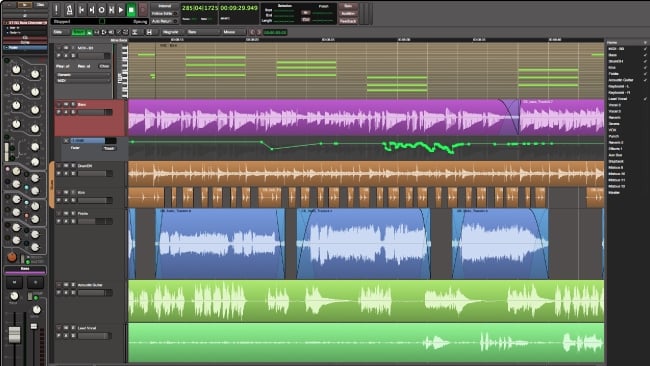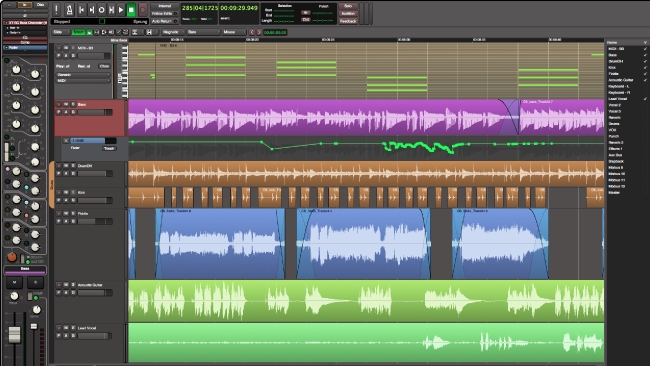
 Harrison Mixbus32C
Harrison Mixbus32C
Harrison's new Mixbus32C is the company's impressive attempt to emulate the character of its classic analogue consoles for the digital age.
You may not have noticed CPU clock speeds increasing much over the past decade, but that doesn't mean that computers haven't been getting faster. Harrison says that its new Mixbus32C wouldn't have worked five years ago.
It's certainly an ambitious product, based around a complete emulation of Harrison's classic analogue consoles. And when it says "complete emulation," it really means it. Mixbus32C doesn't just resemble the layout of a channel strip on a real Harrison console, it actually sounds like it - convincingly.
Computer-based mixing has moved beyond the basic function of combining multiple channels of digital audio. There's now enough compute power to emulate analogue processes, as if they were in the analogue domain – complete with all those desirable analogue characteristics. Apparently, Mixbus32C can simulate analogue tape saturation, as well as the usual EQ and compression.
Amazingly, it goes even beyond this level of analogue authenticity by digitally modelling "every resistor, capacitor and transistor," according to Harrison's website.
Mixbus32C is a powerful DAW in its own right, running on Windows, OS X and Linux, and it can use the industry standard plug-ins for each host platform.
We think this new version of Mixbus is a huge achievement and, at $299, is well worth a look.
Mixbus32C features
Straightforward "knob per function" mixer layout based on Harrison's renowned 32-series music consoles
Precise emulation based on Harrison's famous 32 series analog console circuit designs
Precision algorithms for EQ, Filter, Compression, Analog Tape Saturation, and Summing
Fourth-generation Harrison "True Analog Mixing™" processing engine with enhanced compressor/limiter algorithms; built-in sidechain busing and increased plugin flexibility
The Mixbus32C engine is internally dithered, ramped and gain staged so that sound quality is preserved as close to analog as possible
Unlimited stereo or mono input channels, each with unlimited plugins, sends and hardware inserts (limited only by CPU and disc speed)
Unlimited MIDI tracks, each with virtual instrument support, unlimited plugins, sends and inserts
Phase, Input trim, Sweepable 4-band EQ with second order HP and LP filters, Compression and 12 mix bus sends on every track
Mixbus32C has an optimized signal flow with 12 stereo mix buses and a master bus, all featuring Tone controls, Compression, Sidechaining, and Analog Tape Saturation simulation
Stereo Master bus that features Tone controls, Analog Tape Saturation, K-meter, Stereo Correlation Meter, and Limiter
Automatic plugin delay compensation to support effects such as parallel compression without time misalignment
Comprehensive "at-a-glance" metering with peak, peak hold and compressor gain reduction visible on every track and bus
Extensive DAW editing features including "Smart Tool," Ripple Edit, and configurable keybindings for nearly every operation
Industry standard plug-in support: Mixbus32C loads VST plugins on Windows, AudioUnit (AU) plugins on OSX, and LV2 plugins on all platforms
Industry standard audio I/O support: Mixbus32C uses ASIO/Directsound on Windows, CoreAudio on OSX, and ALSA/JACK on Linux
Mixbus32C provides professional features such as Loudness Analysis (dBTP+LUFS+LU Range), LTC (SMPTE) generation and sync; video pullup/pulldown
Persistent undo (undo remains possible after closing and reopening a session)
Multi-core and 64-bit optimizations provide increased track counts across all OS platforms
Over 50 MIDI filter plug-ins, including functions such as transposing, velocity scaling, etc
Support for video timeline, video window, and audio+video exports
Includes a brand-new virtual instrument: "SetBfree," a lovingly modeled Tonewheel Organ by Robin Gareus plus Harrison's Dyno-Mite envelope-designer plug-in for drums
Recording operates like a tape machine: punch-in on the fly, and use per-track input monitoring just like a multitrack tape machine
Extensive export features including multitrack stem export, simultaneous multi-format exports, multiple export ranges, CD track markers, silence trimming, normalization, and command-line arguments to trigger third-party encoders or file-management scripts
Audio regions are stacked in "layers" and every region fadein/out is a crossfade to the region(s) beneath it
Plugin "pin connection management" provides rich editing of signal-flow through each channel's path, including full support for dual mono, mono-to-stereo, sidechaining, and other advanced flows
The user interface scales to fit your monitor; larger monitors will get bigger knobs and sharper text
Refined workflow and graphics, including scaling and support for HiDPI (Retina) displays
Incredibly cost effective because of our world-wide open source collaborators
Generic MIDI devices can use "MIDI Learn" to assign MIDI controls directly to on-screen knobs or use MIDI profiles to select many pre-configured device layouts from a pull-down menu
Mackie control protocol is provided for motorized fader controllers, and the Mackie protocols have been extended to ergonomically control the Mixbus channelstrip EQ, compressor, and 12 mix bus sends. Dedicated support is provided for popular devices like the Presonus Faderport, Mackie MCU, and Behringer X-Touch controllers
OSC (Open Source Control) protocol supports ethernet-based wireless tablet controllers such as TouchOSC and Lemur for iOS and Android to remote-control Mixbus32C
Mixbus32C will open Mixbus sessions. However, the EQ will not covert since they are completely different.
Tags: Audio


Comments